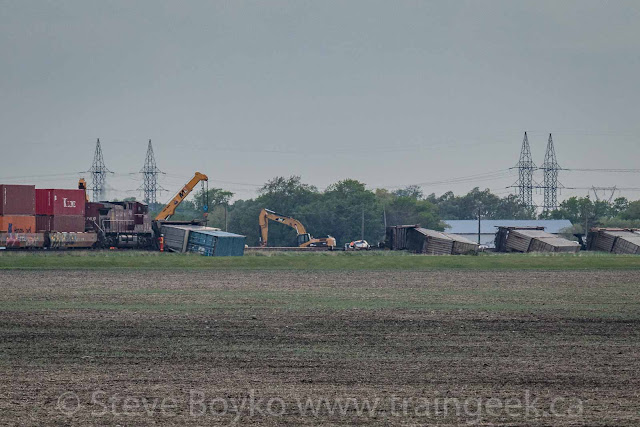You may have seen footage of train derailments. Hopefully you’ve never seen one in person. They can be massive and they are dangerous.
How do train derailments happen? How can they be prevented?
There are five major causes of train derailments:
- Grade crossing collisions
- Broken rails
- Excess speed
- Human error
- Weather
Let’s look at each one.
Grade Crossing Collisions
When a train hits a car or truck at a crossing, the train always “wins”. It is much, much larger and heavier than any truck. However, it is possible that a collision at a “grade crossing” (where a road crosses a track at track level, not an overpass or underpass) can cause a locomotive to derail. If that happens, then the locomotive(s) and cars behind the lead locomotive may also derail.
The train emergency brakes will come on – either applied by the engineer just before the collision, or automatically when a train air hose separates – and the train will come to a halt. Sometimes when a train “goes into emergency” the rail cars may not all stay on the track, depending on whether the train is on a curve or a hill, and how quickly each car can brake.
Organizations like Operation Lifesaver are working to reduce the number of grade crossing collisions through education, while governments and railways are working to add gates to crossings and close unsafe crossings.
Broken Rails
Trains depend on the rails they ride upon to carry them safely to their destination. These rails do wear over time, and sometimes they will develop cracks or pieces will break off due to the punishing amount of wear they receive from heavy trains. Sometimes a rail will “roll” sideways instead of staying vertical.
When a rail breaks, it is likely that the next train will derail at that site. This can lead to a catastrophic train derailment involving many cars, as the derailment can happen at relatively high speeds.
Railways undertake regular track inspections to find weaknesses in the rails before they break. These inspections are done with automated machines from companies like Pandrol or Herzog, as well as visual inspections by track foremen.
Track with CTC signaling will automatically detect broken rails because the signal circuit will be broken when a rail is broken. Railways are adding broken rail detection circuitry to “dark” territory where no track signals exist.
Excess Speed
Every section of rail has a speed limit, just like a road or highway does. These limits are set by the railway and are determined by the condition of the track, how many curves it has and how sharp they are, the presence of hills, and so forth. These speed limits are indicated by signs along the track and also in the employee timetable issued by the railway.
If a train exceeds the speed limit, it is possible that it will derail, especially on a curve in the tracks. Some recent examples of derailments due to speed include a 2013 Spanish derailment, where the train was traveling at twice the speed limit, and the 2017 Amtrak derailment in Washington state where the train exceeded the speed limit by almost 50 MPH.
Excess speed derailments can occur due to mechanical issues, usually on a downhill run where the train’s brakes are unable to slow the train, but are typically caused by human error, discussed next.
Human Error
There are many potential human errors that can cause trains to derail or crash. This section will discuss two major ones: switching errors and missing signals.
Trains change tracks by going through switches that are either manually changed, or remotely by the dispatcher. If a train rolls through a switch that is set for the wrong track, they can go onto a track that may already have standing cars in it – causing a collision – or just derail.
Other switching errors can include parking rail cars too close to a switch so that a train passing on the next track sideswipes the cars.
Railways have signals indicating whether trains can pass the signals, much like stop lights. These signals also can indicate the maximum speed the train can go in the section of track past the signal. If the crew misreads the signals or doesn’t see them, they can enter a section of track occupied by another train or proceed through a section of track at a higher speed than they should.
Positive train control (PTC) is a relatively new development that aims to reduce or eliminate these signal problems by automatically notifying the crew if they pass a signal and applying brakes if necessary to slow or stop the train.
Weather
Trains can usually power through most severe weather, but they can fall prey to certain kinds of weather. Two main weather-related causes of derailments are high winds and high temperatures.
Trains are heavy and have no real trouble with headwinds. However, strong winds from the side can blow tall cars over, like double-stacked container cars. Several of these derailments have occurred in Canada. I photographed the aftermath of a Canadian Pacific derailment caused by high winds in May 2018. Just over a dozen cars blew over.

Railways generally run tall trains like container trains at slower speeds during high wind conditions to mitigate the problem.
High temperatures can cause “sun kinks“. Steel rails expand in hot weather, and if there aren’t large enough gaps between rails, the rails have nowhere to expand to, so they buckle. This causes the rails to twist and the distance between the rails is no longer the standard 4′ 8.5”. This can derail a train rolling over the gap.
Railways reduce the speed of trains during high temperatures to give crews more chance to detect sun kinks.

